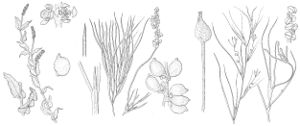Ruppia
Sp. Pl. 1: 127. 1753;, Gen. Pl. ed. 5; 61, 1754.
| Taxon | Illustrator ⠉ | |
|---|---|---|
 | Stuckenia pectinata Ruppia maritima Potamogeton richardsonii | John Myers John Myers John Myers |
Herbs, rooting at proximal nodes. Leaves: blade entire proximally, minutely serrulate distally, apex ± obtuse to acute; veins 1. Inflorescences fewer than 20-flowered, at first enclosed by sheathing leaf-bases. Flowers bisexual; anthers 2-loculed, locules separated by broad connective; stipe elongating after anthesis. Fruits beaked, long-stipitate; beak erect or slightly recurved.
Distribution
Almost worldwide
Discussion
Considerable confusion exists about North American taxa of Ruppia. Two distinct forms, along with several intermediates, are known: one with short peduncles with four or fewer spirals and another with long peduncles with five or more coils (often many more). Usually, those with few coils are in brackish waters near the coast, whereas those with many coils are inland, often in lakes that have high mineral contents. The forms have been considered variants variants of one species, R. maritima (M. L. Fernald and K. M. Wiegand 1914); more recently they have been accepted at species level (R. F. Thorne 1993). I am adopting Thorne’s concepts.
Species ca. 10 (2 in the flora).
Selected References
Lower Taxa
Key
| 1 | Peduncle with 5 or more coils in fruit, longer than 30 mm; plants mostly from inland localities | Ruppia cirrhosa |
| 1 | Peduncle with fewer than 5 coils in fruit, shorter than 25 mm; plants mostly from coastal localities | Ruppia maritima |
"elongating" is not a number."elongating" is not a number.